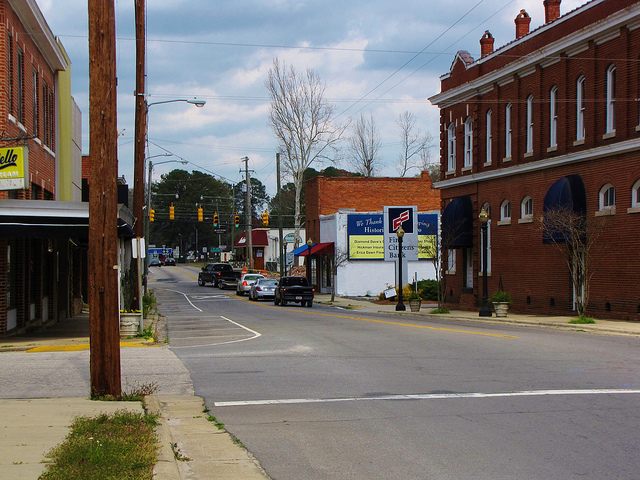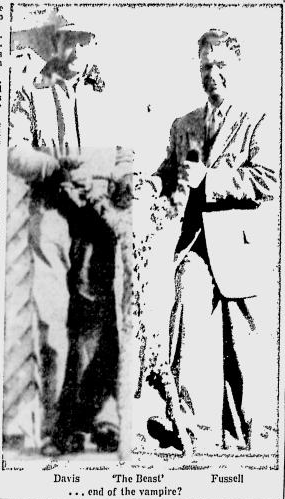North Carolina’s 1932 Series of Spontaneous Combustions is Still Unsolved

Mysterious fires: in 1932, 20 fires broke out in a house in Bladenboro, North Carolina. (Photo: Lukas Gojda/shutterstock.com)
More than half a century before A Nightmare On Elm Street scared the bejesus out of American moviegoers, one family in North Carolina experienced a true nightmare on Elm Street.
It happened more than 80 years ago in the small, rural town of Bladenboro, North Carolina, where a series of nearly two dozen mysterious fires ignited at the family’s farmhouse becoming the talk of the town for weeks. The fires, which occurred over three days, baffled the family, as well as local and state investigators. They were certainly abnormal, but were they paranormal, too?
Well, that depends on whom you ask.

The quiet Main Street of Bladenboro, North Carolina. (Photo: Gerry Dincher/flickr)
Newspaper accounts of the day relay the indisputable facts: Between January 30 and February 1, 1932, some 20 fires erupted in five different rooms at the Elm Street home of Council H. Williamson and his wife, Lydia. Items such as curtains, tablecloths, and a pair of trousers—and, in one particularly terrifying instance, a dress worn by a young girl—simply burst into flames for no apparent reason. When the fires were extinguished, no one could figure out what had sparked them. Equally puzzling, household objects near the burned items showed no signs of burn marks or even smoke damage.
Headlines played up the mystifying nature of the blazes: “Phenomenal Fires Visit Bladenboro.” “Mysterious Fires Occur In Residence.” “Strange Phenomenon Puzzles Citizens—Fires Break Out Most Unaccountably.” “House of Many Fires Sets N.C. Town Wild.”
King Features Syndicate even created a full-page story and photo package about the mystery for its member newspapers across the country, under the tantalizing headline, “The Very Puzzling Mystery of the Bladenboro Fires.” A subhead added, “First a Weird Blaze in Mr. Williamson’s Home, Then Another and Another and Then His Daughter Caught Fire—and Nobody Can Explain.”

A 1911 depiction of a poltergeist activity. (Photo: Public Domain/WikiCommons)
Nobody could explain, but they sure tried. As newspaper accounts detailed, the first fire happened late in the afternoon of January 30, when a window shade and curtain burned in the dining room. Not long after it was extinguished, another shade in the same room caught fire. The next day, with guests visiting the Williamson family, a set of bedclothes ignited and burned rapidly. Another fire incinerated a stack of papers that had been stored in a closet. Later in the day, a pair of trousers hanging in a closet met the same fiery fate. To top it all off, a young girl in the home, believed to have been the Williamsons’ granddaughter, barely escaped getting burned when her dress mysteriously ignited.
The last of the 20 fires happened around noon on February 1, 1932—the third consecutive day a fire had ignited mysteriously. “The house is closely guarded, and no one is allowed to enter,” the Bladen Journal reported. “The family has moved out, and particles of the burned materials have been sent to the state chemist in the hope that a solution to the mystery may be found. Mr. and Mrs. Williamson are citizens of the highest type and are in great distress over the unusual occurrences.”
To our knowledge, this burning mystery was never solved. It doesn’t appear that the Bladen Journal or other newspapers of the day published any follow-up stories about the Williamsons’ horrific ordeal. Those who investigated—fire science experts, chemists, police officers, private investigators—apparently all came up empty. More than 80 years later, any potential clues have long since been extinguished, the old farmhouse having been torn down decades ago.

Another local mystery, the “Beast of Bladenboro”: Luther Davis and Mayor Woodrow Fussell next to the bobcat Davis trapped, January 1954. (Photo: Public Domain/WikiCommons)
Nonetheless, modern-day “experts” are perfectly willing to weigh in on the Bladenboro mystery. One man, in particular, says there is no logical explanation for what happened, but there is an illogical explanation.
“It sounds like the classic poltergeist fire phenomenon, where objects other than humans spontaneously burst into open-flame combustion,” author Larry Arnold, wrote about the Bladenboro fires in his 1995 book, Ablaze! The Mysterious Fires of Spontaneous Human Combustion, told a reporter several years ago.
So were the Williamsons sharing their home with a pyromaniac poltergeist? Arnold stopped short of saying so definitively, explaining that history hasn’t provided us with enough information.
“These cases are fleeting, spontaneous and quite baffling,” he said, “and in almost every case are denied by the mainstream scientific community and the fire science community.”
You can add Joe Nickell’s name to that list of naysayers. Nickell is a senior research fellow of the Committee for Skeptical Inquiry—an international scientific organization—and investigative columnist for Skeptical Inquirer magazine. Nickell was not familiar with the Bladenboro case, but after reading through a few newspaper articles from 1932, he had all the fodder he needed to cast doubt on the notion of any sort of paranormal activity.
And while there is such a thing as spontaneous combustion such as a pile of oily rags generating heat over time and eventually bursting into flame, the Bladenboro fires do not fit into that category, according to Nickell. To the contrary, he believes a person triggered those mysterious blazes in the Williamsons’ house.
“This is very, very common. It’s exactly like several cases we know full well about of so-called poltergeist phenomena,” Nickell says.
The scenario is this: A family experiences an outbreak of some sort of mischief, such as stones being hurled at a house, objects being thrown inside a house, items disappearing from one room and mysteriously showing up in another, or, in this case, a series of small fires inexplicably popping up throughout a house. With no logical explanation readily available, it’s almost as if, Nickell says, a poltergeist has taken up residence there.
“That’s the allegation, but it doesn’t actually exist,” Nickell says. “What’s happening is, there’s usually a small boy or girl in the house who’s doing it, and in many of these cases they’ve actually been caught doing it.”
Nickell points to a fairly well-known case that happened in Talladega, Alabama, in 1958, when dozens of small, unexplainable fires repeatedly ignited at the home of Calvin Tuck Sr. The bizarre fires spooked Tuck so badly that he reportedly visited a witch doctor and procured a prescription that was supposed to put a stop to the fires. What ultimately put out the fires, though, was a confession by the real culprit, according to local police—9-year-old Calvin Tuck Jr. The family reportedly had moved, and an unhappy young Calvin wanted to move back to where his friends lived.
Nickell believes that’s what happened in the Bladenboro case, too.
“As soon as I hear this, I start wondering if there were children in the house,” he says, “Well, guess what? Yeah, there were.”










Follow us on Twitter to get the latest on the world's hidden wonders.
Like us on Facebook to get the latest on the world's hidden wonders.
Follow us on Twitter Like us on Facebook